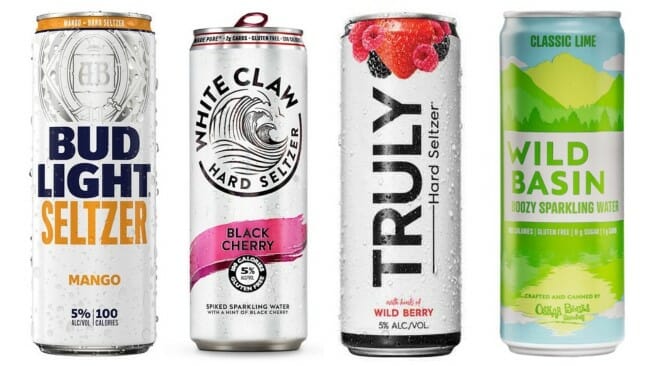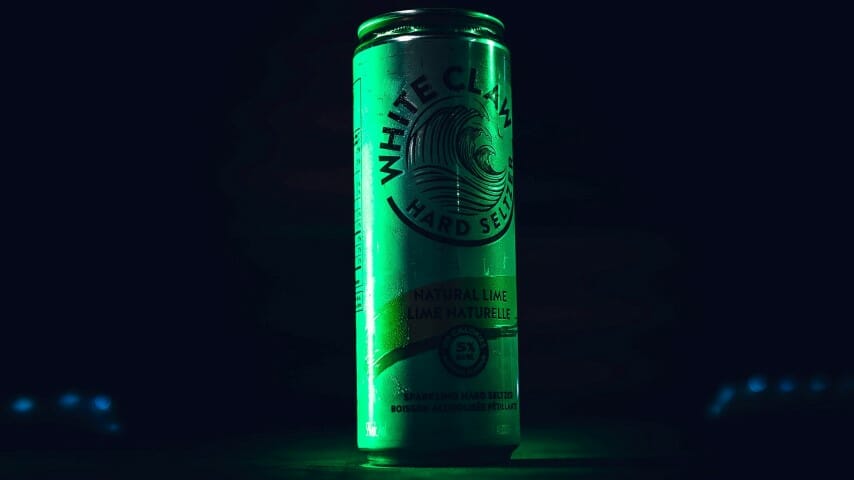Cocktail Queries is a Paste series that examines and answers basic, common questions that drinkers may have about mixed drinks, cocktails and spirits. Check out every entry in the series to date.
Ask your average drinker to describe hard seltzer as a category, and they’ll probably use the word “simple” at some point. That’s part of the allure of hard seltzers—they’re meant to be uncomplicated beverages with easily accessible flavors that don’t require any thought or contemplation.
But ask that same person to explain what exactly hard seltzers are, and you’re likely to run into some confusion or misinformation. Because despite how phenomenally popular the hard seltzer category—and White Claw in particular—have become in the U.S. over the last few years, few drinkers seem to understand what they truly are at all. It’s just another part of the seltzer mystique; a willingness to look past the fact that most people have no idea how they’re made or defined. This summer, it might well be the most popular and most commonly misunderstood beverage on the market.
So let’s clear a few things up. What exactly defines a hard seltzer? How are they made? And why did they catch fire and become so incredibly popular, seemingly overnight, with sales that continue to surge even through the pandemic?
Defining Hard Seltzer
Truly defining hard seltzer is harder than it initially sounds, because hard seltzers probably aren’t quite what you assume them to be. Especially given that hard seltzers such as White Claw are so often compared to mixed drinks like a vodka soda, the most natural assumption for the consumer would probably be that hard seltzers are simply sparkling water, mixed with a bit of high-proof neutral spirit (like vodka, or grain alcohol) and fruit flavoring. That would essentially make them canned mixed drinks.
Hard seltzers, however, aren’t made that way. Rather, the standard 5% ABV in hard seltzer brands comes as the product of fermentation, making them more closely related to beer than they are to hard spirits. A few brands achieve this alcohol through the fermentation of regular old cane sugar, but the biggest brands (White Claw, once again) are getting their alcohol from the fermentation of malted barley. This puts White Claw into a category the alcohol industry generally refers to as “flavored malt beverages,” or FMBs. Perhaps unsurprisingly, they don’t share a lot more details on the brewing process.
FMBs are a category that has traditionally included such saccharine delights as Smirnoff Ice and Mike’s Hard Lemonade, the latter being essentially White Claw’s sister beverage, as both are owned and produced by the Mark Anthony Group. However, White Claw and co. diverged from the typically FMB playbook in one very important way—they were developed to be dry, rather than tooth-strippingly sweet.
This really was a revelation, and one that the earliest hard seltzer makers deserve considerable credit for capitalizing on, because it runs so very against the prevailing alcohol industry norm of preying on the audience’s craving for sugar. Most American drinkers love sugar and sweetness whether or not they’re able to admit it, and are drawn to it like moths to flame, but hard seltzer manufacturers were betting there was a niche out there also craving a dryer, crisper, but still artificially flavored beverage. And they were right, and then some. Ultimately, this is the main thing that sets a White Claw (100 calories, 2 g carbs) apart from a Mike’s Hard Lemonade (220 calories, 33 g carbs)—they’re both artificially flavored booze meant for mass consumption, but one is just a lot less sweet.
The major seltzer brands have seized on this perceived niche with marketing that presents hard seltzer as a middle ground between various, “too extreme” ends of the alcohol spectrum. The Truly website, for instance, immediately proclaims that cocktails are “too boozy,” wine is “too bottled” and beer is “too bloaty,” with the obvious implication being that seltzer fills all of your needs, without the drawbacks. Is that a massive oversimplification? Well yeah, pretty much, but it’s an attractive one.
 All the major seltzer brands benefit from similar marketing and the perception that they’re “healthier” than other alcoholic beverages.
All the major seltzer brands benefit from similar marketing and the perception that they’re “healthier” than other alcoholic beverages.
Why Are Hard Seltzers So Popular?
If you want to summarize the popularity of hard seltzer, you can more or less attribute it to three major bullet points: Novelty/accessibility, guiltlessness and pop cultural appeal.
In terms of novelty/accessibility, White Claw and its ilk simply represented something that felt new and fresh to the consumer when it arrived, while also being familiar enough (because of the surging popularity of zero-calorie, non-alcoholic seltzer waters) that people weren’t afraid to try them. They were freely available and had the backing of national distribution from major companies. Hard seltzers showed up everywhere, very quickly, with easily understood fruit flavor combinations that evoked consumer memories of popular, accessible mixed drinks. They were uncomplicated and unpretentious, and that makes for mass appeal. However, unlike the brief fad for alcoholic sodas (remember the Not Your Father’s Root Beer craze?), hard seltzer carved out a real chunk of the market and held it. Why?
A big part of that answer is the second bullet point: Guiltlessness. Although a lot of consumers were no doubt curious about something like a sugary, alcoholic root beer, those purchases proved to be driven by pure novelty, rather than a desire to drink that product on a daily basis. Hard seltzer, on the other hand, aimed to make itself part of every yuppie’s “active lifestyle” by playing up its perceived “better for you” health status, leaping onto the same market that had seen a constantly expanding Michelob Ultra become one of the most important products in the beer industry. This market of health-conscious consumers was out there, and there’s something about this demographic that is often overlooked: These people still want to drink, and plenty of them want to drink heavily. Specifically, they want a low-calorie, low-carb product they can pound en masse, and then “work off” in tomorrow’s run. It’s the “work hard, play hard” mindset.
Hard seltzer taps expertly into that guiltless consumption model, because the marketing, focusing heavily on calories/sugar/carbs makes the case to the consumer that they don’t have to put any limit on how much White Claw, etc. they’re drinking. The alcohol content is almost entirely ignored in this context—what matters is how many calories you’re not drinking, compared to beer, wine or more sugared FMBs. There’s no way to spin ethanol itself into a health benefit, so its presence is minimized, despite the fact that standard strength hard seltzers contain significantly more alcohol than flagship domestic light beers.
One might expect this focus on calories, and the bevy of fruit flavors, to make hard seltzers popular exclusively with a female demographic, and not necessarily with men who are expected to shun products with the implication of “diet culture” written on them, but this is where our third bullet point comes into play: pop cultural appeal. It’s this adoption of hard seltzer (especially White Claw, once again) by internet culture and unexpected subgroups that helped to push the entire category into the mainstream. Now, it’s been co-opted by many groups—not just the expected health-conscious drinkers, but also by the most aggressive of bros. White Claw found ways to appeal to every one of them, whether they were gearing up for a run or passed out in a kiddie pool.
This adoption has perhaps signaled a generational shift, going hand in hand with the dethronement of other products that were once seen as icons of masculinity. Once upon a time, there was nothing more “manly” than American domestic lager, but as I once saw a sage observer state on Twitter: “Marlboro and Bud is now Juul and White Claw.” This modern male consumer isn’t being stigmatized for wanting something like a light, fruity drink, which has allowed White Claw to be adopted in communities where you’d expect it to be seen as “girly.” That even includes far-right wing, gun-toting militants like the so-called “boogaloo boys,” who have adopted White Claw and its unofficial “ain’t no laws when you’re drinking claws” slogan as the group’s alcoholic spirit animal. As it turns out, nothing goes better with planning a second civil war than the refreshing flavor of a Black Cherry White Claw.
And there you have it—White Claw, and hard seltzer as an extension, have managed to assemble a coalition that most politicians would kill to possess. They found an underserved niche of the alcoholic beverage market and rapidly filled it, picking up drinkers along the way who aren’t typically interested in FMBs. They made themselves into pop culture sensations with seemingly unlimited growth potential, even as the ongoing pandemic hampers other segments of the alcohol industry. There really doesn’t seem to be any stopping them—if you don’t like hard seltzer, you can only hope to glean some insights from it.
Jim Vorel is a Paste staff writer and resident liquor geek. You can follow him on Twitter for more drink writing.

 All the major seltzer brands benefit from similar marketing and the perception that they’re “healthier” than other alcoholic beverages.
All the major seltzer brands benefit from similar marketing and the perception that they’re “healthier” than other alcoholic beverages.